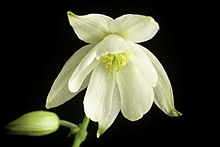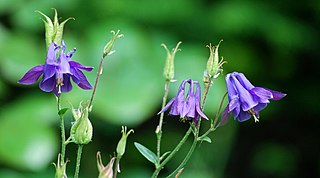
Aquilegia is a genus of about 130 species of perennial plants that are found in meadows, woodlands, and at higher elevations throughout the Northern Hemisphere, known for the spurred petals of their flowers.

Aquilegia canadensis, the Canadian or Canada columbine, eastern red columbine, or wild columbine, is a species of flowering plant in the buttercup family Ranunculaceae. It is an herbaceous perennial native to woodland and rocky slopes in eastern North America, prized for its red and yellow flowers. It readily hybridizes with other species in the genus Aquilegia.
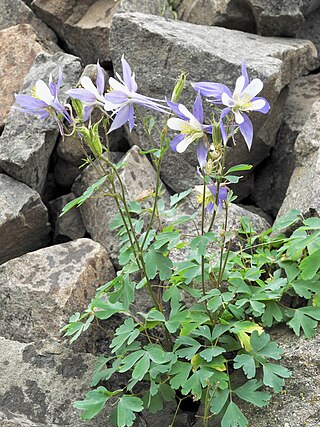
Aquilegia coerulea, the Colorado columbine, Rocky Mountain columbine, or blue columbine, is a species of flowering plant in the buttercup family Ranunculaceae, native to the Rocky Mountains and some of the surrounding states of the western United States. It is the state flower of Colorado. The Latin specific name coerulea means "sky blue".
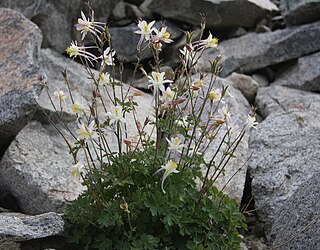
Aquilegia pubescens is a perennial flowering plant in the family Ranunculaceae, endemic to the Sierra Nevada in California. It is usually known by the common name Sierra columbine, and less frequently as the alpine columbine or Coville's columbine.

Aquilegia chrysantha, the golden columbine, is a perennial herbaceous flowering plant native to the southwestern United States and northwestern Mexico. The plant, with a height of between 40 centimetres (16 in) and 120 centimetres (47 in), has yellow flowers. A. chrysantha. as with other members of the Aquilegia coerulea species complex, is evolved for pollination by hawkmoth. It favors moist environments in its mountainous range.
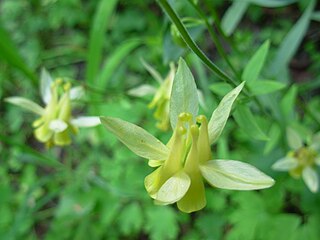
Aquilegia flavescens, the yellow columbine, is a perennial species of flowering plant in the family Ranunculaceae, native to the Rocky Mountains of the United States and Canada.

Aquilegia pyrenaica, common name Pyrenean columbine, is a species of flowering plant in the family Ranunculaceae. It is endemic to the Pyrenees where it grows on grassland and in rocky places. It was first described in 1805 by Augustin Pyramus de Candolle who gave it the name Aquilegia pyrenaica.

Aquilegia longissima, the long-spur columbine or long-spurred columbine, is a rare perennial flowering plant in the family Ranunculaceae that is native to northern Mexico, Texas, and Arizona.
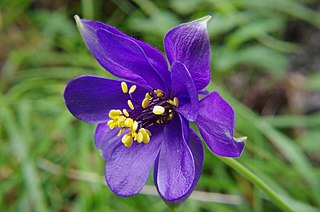
Aquilegia alpina, the alpine columbine or breath of God, is a perennial species of flowering plant in the family Ranunculaceae, native to the western and central Alps.

Aquilegia olympica is a perennial flowering plant in the family Ranunculaceae, native to Turkey, Iran, and the Caucasus.

Aquilegia viridiflora, commonly known as the green columbine or green-flowered columbine, is a perennial flowering plant in the family Ranunculaceae, native to southern Siberia, northern China, Mongolia, and Japan.

Aquilegia ottonis is a perennial flowering plant in the family Ranunculaceae, endemic to Greece.
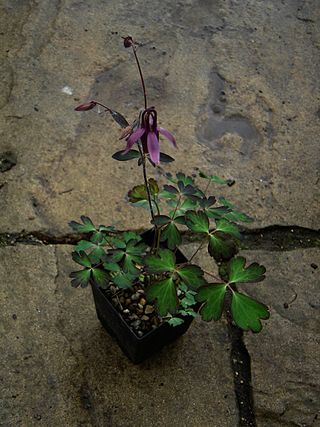
Aquilegia rockii is a perennial flowering plant in the family Ranunculaceae, native to southern China.

Aquilegia skinneri, commonly known as the Mexican columbine or Skinner's columbine, is a perennial flowering plant in the family Ranunculaceae, native to Mexico and Guatemala.

Aquilegia sibirica, the Siberian columbine, is a species of flowering plant in the family Ranunculaceae native to the north-central Asian regions of Siberia, northern Mongolia, Kazakhstan, and Xinjiang. A hardy perennial plant, it prefers temperate environments. The Siberian columbine can be between 1 foot (0.30 m) and 2 feet (0.61 m) tall with flowers that are lilac-blue and white in color.

Aquilegia desertorum, the desert columbine, is a perennial species of flowering plant in the family Ranunculaceae, native to the Southwestern United States.

Aquilegia einseleana, or Einsele's columbine, is a perennial species of plant in the family Ranunculaceae, native to the eastern Alps.

Aquilegia glandulosa, the Altai columbine or Siberian columbine, is a perennial species of flowering plant in the family Ranunculaceae, native to northern and central Asia.
Aquilegia incurvata, or the Qinling columbine (秦岭耧斗菜), is a perennial species of flowering plant in the family Ranunculaceae, endemic to the Qinling mountain range in China.
Aquilegia baluchistanica, common name the Balochistan columbine, is a perennial flowering plant in the family Ranunculaceae, endemic to Pakistan.

